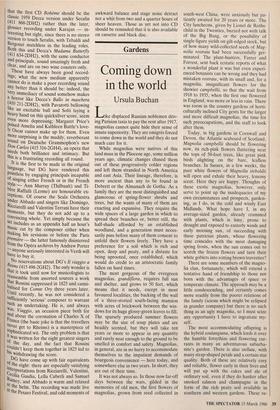Gardens
Coming down in the world
Ursula Buchan
Like displaced Russian noblemen driv- ing Parisian taxis to pay the rent after 1917, magnolias cannot quite hide their sense of innate superiority. They are emigres forced to come down in the world and they do not much care for it.
While magnolias were natives of this land mass in the Pliocene age, some million years ago, climatic changes chased them out of these progressively colder regions and left them stranded in North America and east Asia. Their lineage, therefore, is more ancient than any to be found in Debrett or the Almanach de Gotha. As a family they are the most distinguished and glamorous of spring-flower shrubs and trees, but the wants of many of them are exacting and expansive. They require the wide spaces of a large garden in which to spread their branches or, better still, the half-shade afforded by an established woodland, and a generation must neces- sarily pass before many of them consent to unfold their flowers freely. They have a preference for a soil which is rich and open, deep and peaty, and a distaste for being uprooted, once established, which would do credit to an aristocratic family fallen on hard times.
The most gorgeous of the evergreen magnolias, grandiflora, requires full sun and shelter, and grows to 50 feet, which means that it needs, except in most favoured localities, the backing of the wall of a three-storied south-facing mansion with acres of brickwork between the win- dows for its huge glossy-green leaves to fill. The sparsely produced summer flowers may be the size of soup plates and are headily scented, but they will take ten years or more to appear in any quantity and rarely near enough to the ground to be smelled in comfort and safety. Magnolias, in general, are in no hurry to accommodate themselves to the impatient demands of bourgeois convenience — here today, and somewhere else in two years. In short, they are out of their time.
It was not always so. In those now far-off days between the wars, gilded in the memories of old men, the first flowers of magnolias, grown from seed collected in south-west China, were anxiously but pa- tiently awaited for 20 years or more. The City luncheons, given by Lionel de Roths- child in the Twenties, buzzed not with talk of the Big Bang, or the possibility of single-figure yields on gilt-edged stock, but of how many wild-collected seeds of Mag- nolia rostrata had been successfully ger- minated. The plant-hunters, Farrer and Forrest, sent back ecstatic reports of what a wonderful plant it was but even experi- enced botanists can be wrong and they had mistaken rostrata, with its small and, for a magnolia, insignificant flowers for the showier campbellii, so that the wait from 1918 to 1935, when the first one flowered in England, was more or less in vain. There was room in the country gardens of horti- culturally inclined City gents for the larger and more difficult magnolias, the time for such preoccupations, and the staff to look after them.
Today, in big gardens in Cornwall and Devon, the Atlantic seaboard of Scotland, Magnolia campbellii should be flowering now, its rich-pink flowers fluttering near the tops of 50-foot trees, like great pink birds alighting on the bare, leafless branches. In Sussex, in a few weeks, the pure white flowers of Magnolia sieboldii will open and exhale their heavy, lemony scent. Here they are happy. Thoughts of these exotic magnolias, however, only serve to point up the inadequacies of my own circumstances and prospects, garden- ing, as I do, in the cold and windy East Midlands. What hope have I, in my average-sized garden, already crammed with plants, which is limy, prone to drought and exposed to easterly winds and early morning sun, of succeeding with these patrician plants, whose flowering time coincides with the most damaging spring frosts, when the sun comes out to scorch the frozen flowers and turn their white goblets into rotting brown travesties?
There are some members of the magno- lia clan, fortunately, which will extend a tentative hand of friendship to those not born with the advantages of space or temperate climate. The approach may be a little condescending, and certainly comes more readily from the poorer relations of the family (scions which might be eclipsed in grander company) but there is no such thing as an ugly magnolia, so I must seize any opportunity I have to ingratiate my- self.
The most accommodating offspring is the hybrid soulangiana, which lords it over the humble forsythias and flowering cur- rants in many an adventurous suburba- nite's garden. There is also stellata, with many strap-shaped petals and a certain star quality. Both of these are relatively easy and reliable, flower early in their lives and will put up with the cakes and ale of ordinary soil, even if they do hanker after smoked salmon and champagne in the form of the rich peaty soil available in southern and western gardens. These re- solutely refuse to grow into stately trees, preferring to remain as more lowly shrubs. I shall shortly be planting M. x highdow- nensis in my garden and, if I had acid soil, I would plant its parent, M. wilsonii; these will grow against a medium-sized wall, and do not open their cup-shaped flowers till May. The modern city man in Clapham or Islington should find room for the deep pink 'Leonard Messel', named after the banker who lived at Nymans in Sussex.
Gardeners, however, who do not feel up to the strain of putting these lofty and rather tricky guests at their ease, might like to go in April to gaze at them in their public finery, at Nymans or Leonardslee in Sussex, at Lanhydrock or Trewithen in Cornwall, at Crarae Glen in Strathclyde — gardens which, like the magnolias, are relics of a more spacious age.



















































 Previous page
Previous page